Japan Environment Quarterly --Vol.7 No.4 December 2002--
Japan-China Environmental Cooperation Week
 |
Opening Ceremony of Environmental Cooperation Week. |
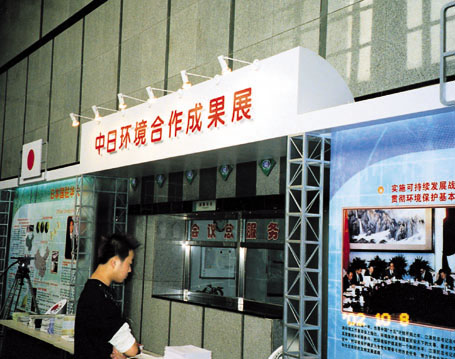 |
Displays in the lobby of Sino-Japan Friendship Center for Environmental Protection. |
Background
To mark thirty years since the normalization of diplomatic relations between Japan and China, Japan-China Environmental Cooperation Week was held from 8 to 12 October this year. A variety of environmental events were held in Beijing during this period, providing opportunities to reflect on environmental cooperation between the two countries and to exchange opinions about how to strengthen it in the future.
About 100 people from Japan joined the activities, coming from the central and local governments, non-governmental organizations, universities, research institutes and the business sector.
Since the normalization of diplomatic relations in 1972 and the start of economic cooperation in 1979, Japan has provided environmental cooperation to China in a variety of forms. In recent years, environmental problems such as air pollution have grown along with China's remarkable economic development, particularly in the coastal regions, raising the importance of environmental cooperation from Japan and other industrialized countries as well as international aid agencies.
Events during Environmental Cooperation Week
The venue for events was the Sino-Japan Friendship Center for Environmental Protection, which was built with grant aid from Japan.
Opening Ceremony
Japan's Hironori Hamanaka, Vice Minister for Global Environ ment Affairs, and Akio Morishima, President of the Central Environ ment Council, and China's Qu Geping, Chairman of the Environ mental Protection and Resource Conservation Committee of the National People's Congress and Xie Zhenhua, Minister of the State Environmental Protection Administration attended the opening ceremony on the first day.
Fourth Meeting of Japan-China Comprehensive Forum on Environmental Cooperation
This was a comprehensive forum for dialogue with govern mental and citizen participants. On the first day, representatives of central and local governments, industry, and NGOs reported about their environ mental activities in both countries. On the second day, two separate sessions were held, one discussing strategies to deal with environmental pollution, and the other discussing nature conserv ation. Participants enjoyed a lively exchange of information and opinions.
International Symposium on dust and sandstorms in North-East Asia
The Sino-Japan Friendship Center for Environmental Protection hosted the first international symposium held in northeast Asia on the topic of dust and sandstorms in North-East Asia with broad regional participation of researchers and governmental personnel from China, Japan, Korea and Mongolia. The various health and environmental issues arising from dust and sandstorms in North-East Asia have been attracting more attention in recent years due to their greater frequency and larger scale. Participants heard presentations of research findings on a variety of related aspects of the problem.
Other Events
In the lobby of the Center a display was set up to exhibit photos, videos, pamphlets and publications on various aspects of Japan-China environmental cooperation, presented by governmental and private-sector organizations from both countries.
In addition, a symposium was organized by non-governmental organizations about paths to achieve sustainable society, an issue for which interest is rapidly growing in China. Besides this, the 6th Meeting of Japan-China Com mittee on Environmental Pro tection Cooperation was held, as a forum for policy dialogue between both countries, based on the Agreement between the Govern ment of Japan and the Govern ment of the People's Republic of China for Cooperation in the Field of Environmental Protection signed in March 1994, and field trips were also organized.
World Summit on Sustainable Development
--Outline of Environment Ministry-Related Side Events--
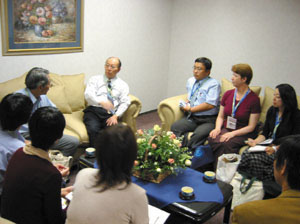 |
Discussion between NGOs and Environment Minister Hiroshi Ohki. |
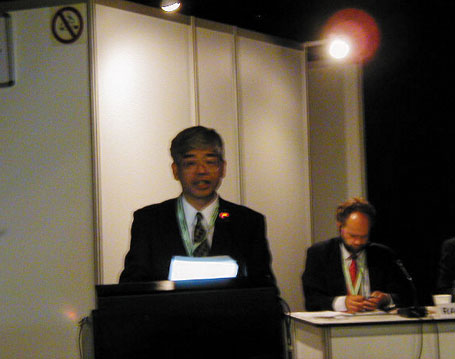 |
Senior Vice-Minister Yamashita speaking at the Japan Pavilion. |
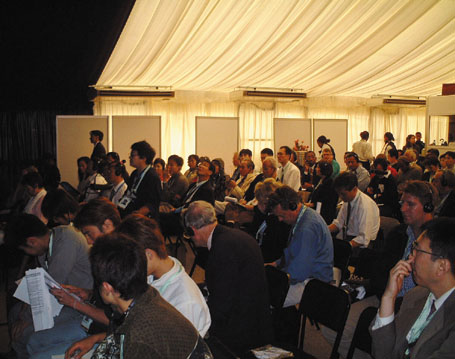 |
MOE-organized seminar "Japan's Challenge for the Implementation of the Kyoto Protocol." |
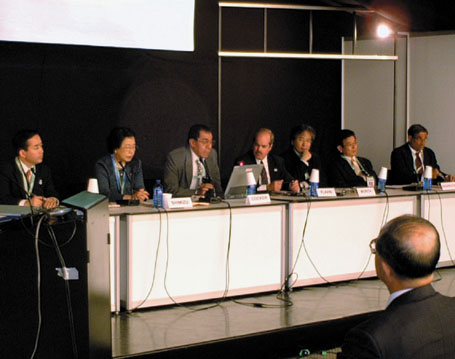 |
Invited speakers discussed climate change and the Kyoto Protocol. |
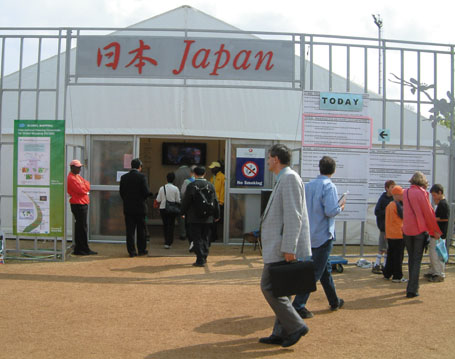 |
Foreground of the Japan Pavilion. |
 |
|
| Panel Display by Ministry of the Environment: In the past, Japan experienced a tragic history of industrial pollution, but since then has been making efforts to realize a sustainable society. At the Japan Pavilion at the WSSD, panel displays and brochures explained Japanese experiences such as Minamata Disease and air pollution, as well as achievements. The panel displays also introduced Japan's efforts to realize a sustainable society, including the biodiversity conservation, combating global warming, and the application of science and technologies for environmental policy development. A demonstration of "e-learning" and computer-based environmental education was also presented. |
|
Substantive discussions and "Type 2" discussions (non-negotiated outcomes aimed at implementing Agenda 21) of the World Summit on Sustainable Development (WSSD) were held at the Sandton Convention Center in Johannesburg. Besides these, organizations or groups that are independent of the United Nations also held a variety of additional events--known as parallel events--under the theme of sustainable development, at venues that included "Ubuntu Village," the "Water Dome" and the NASREC Expo Centre. These activities can be seen as another of the positive outcomes of the WSSD.
At Ubuntu Village, the main attraction was an international exhibition pavilion set up by the South African government, where national governments and international organizations staged exhibitions and seminars relating to sustainable development. The Water Dome featured displays and seminars relating to water, organized primarily by the government of the Netherlands. Non-governmental organizations held exhibitions and seminars at the NASREC Expo Centre.
At Ubuntu Village, the Japanese government's pavilion was beside that of the government of South Africa, and consisted of an display section and seminar rooms. The side events related to Japan's Ministry of the Environment were held mostly at this pavilion.
At the display section, Japan's Ministry of the Environment, with the cooperation of the Institute for Global Environmental Strategies (IGES), exhibited panel displays and distributed various printed materials on such topics as Japan's experience in addressing pollution issues, biodiversity conservation, combating global warming, and the activities of the Asia-Pacific Forum for Environment and Development (APFED).
A total of four seminars were held in the seminar room on 27 and 28 August (see list). The "Japan's Challenge for the Implementation of the Kyoto Protocol" and "New Partnership Initiative for Knowledge Network and Capacity Building" seminars were filled to capacity and had a lively exchange of opinions with many participants. Japan's Ministry of the Environment also cooperated in seminars on "Japan Days," which were organized by Global Environment Action (GEA). Through these seminars it was possible to disseminate much information about the Environ ment Ministry's experiences and technologies.
Besides these events, a concert was held on 28 August at the Gallagher Estate, featuring Ms. Tokiko Kato, a famous Japanese singer, who also serves as a UNEP Special Envoy.
Seminars
|
1. Seminars Sponsored by Ministry of the Environment |
|
(1) 27 August (Tuesday) Innovation from the Asia-Pacific toward Sustainable Development--Initiatives on Science & Technology for Improved Environmental Policy
(2) 27 August (Tuesday)
(3) 28 August (Wednesday)
(4) 28 August (Wednesday) |
| 2. Japan Day: Rediscovering Japan sponsored by Global Environment Action (GEA) in cooperation with Ministry of Environment |
|
(1) 29 August (Thursday) Pollution in Japan: The Battles, The Victories, and Road Ahead
(2) 30 August (Friday) |
|
--Initiatives on Science & Technology for Improved Environmental Policy--
The Ministry of the Environment, Japan and the Institute for Global Environmental Strategies (IGES), in collaboration with the Millennium Ecosystem Assessment (MA), the Asian Development Bank (ADB) and the Asia-Pacific Network for Global Change Research (APN), hosted a side event entitled "Innovation from the Asia-Pacific toward Sustainable Development Initiatives on Science & Technology for Improved Environ mental Policy" on 27 August at the Japan Pavilion in Ubuntu Village. |
|
--Towards new partnerships after the Johannesburg Summit--
The objective of this event was to introduce not only Japan's New National Biodiversity Strategy but also relevant existing initiatives in the Asia-Pacific region. Participants exchanged their views and sought new partnerships after the Johannesburg Summit in order to promote conservation activities in the region. The keynote speakers were from the Japan's Ministry of the Environment, the Critical Ecosystem Partnership Fund (CEPF), and Birdlife International. The event started at 3:00 pm on Tuesday, August 27. |
|
As a WSSD side event, the Ministry of the Environment, Japan, and the Institute for Global Environmental Strategies (IGES) hosted a seminar titled "Japan's Challenge for the Implementation of the Kyoto Protocol." The seminar was held on August 28 in the Japan Pavilion in Ubuntu Village, Johannesburg. |
|
The Ministry of the Environment of Japan, UNEP, UN/ESCAP and the Institute for Global Environmental Strategies (IGES) held a parallel event at the WSSD, entitled APFED Recom mendations and Commitments: A New Partnership Initiative for Knowledge Network and Capacity Building at the Japan Pavilion in Ubuntu Village on August 28, 2002. Approximately 100 persons from international organizations, governments and NGOs partici pated and exchanged their views on future steps for these initiatives. |
US-Japan Migratory Bird Treaty Consultative Meeting in Tokyo
On 16 and 17 October 2002, Treaty Consultative Meeting was held under the auspices of the US-Japan Migratory Bird Convention at the annex building of the Ministry of Economy, Trade and Industry in Chiyoda-ku, Tokyo.
At this meeting, Soichiro Iwao, Director General, Natural Conservation Bureau at the Ministry of the Environment represented Japan, and Paul Schmidt, Deputy Assistant Director of the Migratory Birds and State Programs, Fish and Wildlife Service of the Department of the Interior represented the United States. They exchanged information about regulations and their implementation in both countries to protect migratory birds, and discussed a satellite tracking study of the albatross now being undertaken by both countries, as well as implementation of environmental education programs about shore birds.
This meeting is related to the Convention Between the Government of Japan and the Government of the United States of America for the Protection of Migratory Birds and Birds in Danger of Extinction and Their Environment, which entered into force in 1974. The previous meeting was held in May 2000 in Anchorage, Alaska.
Before the official meeting, the Ministry of the Environment organized the Japan-U.S. Seabird Symposium / Workshop in Haboro, Hokkaido from 12 to 15 October, with cooperation from the U.S. Fish and Wildlife Service and the town of Haboro.
The symposium and workshop brought together governmental officials, experts, NGOs and citizens from both countries who are concerned about the conservation of seabirds. Participants deepened their understanding of the roles and importance of seabirds, and held a wide-ranging exchange of views on the evaluation of initiatives to conserve seabirds and the future of seabird conservation in the North Pacific, with the aim of further promoting such initiatives in both countries.
Miyajima-numa, Fujimae-higata were registrated Ramsar List
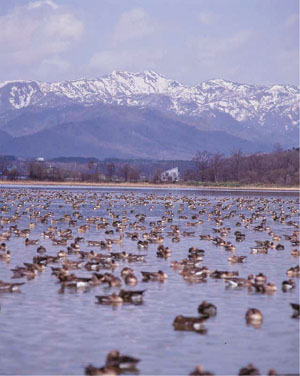 |
Miyajima-numa |
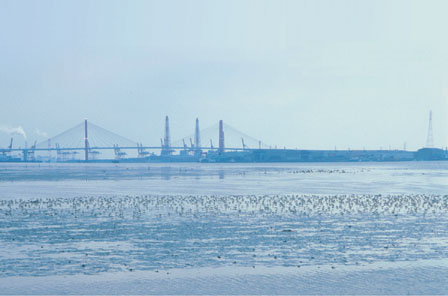 |
Fujimae-higata |
Miyajima-numa (Bibai City, Hokkaido) and Fujimae-higata (Nagoya City and Tobishima Village in Aichi Prefecture) were added to the Ramsar List of Wetlands of International Importance on 18 November. This listing coincided with the first day of the Eighth Conference of the Contracting Parties to the Ramsar Convention (officially known as the Convention on Wetlands of International Importance especially as Waterfowl Habitat). With these two additions, Japan now has 13 listed sites. The main features of the new sites are outlined below.
Miyajima-numa
Miyajima-numa is situated in about the middle of Hokkaido. It is one of the shallow riverbed freshwater lakes along the Ishikari River and surrounded by extensive rice fields. This area is important as a 'staging site' for Anatidae and Swans migrating between their northern hemisphere breeding sites such as in Siberia, and their wintering sites in Japan. It attracts more than 50,000 individuals of migrating white-fronted geese, accounting for about half of the 100,000 to 150,000 of this species that live in East Asian region. Almost all of the white-fronted geese that winter in Japan use the Miyajima-numa as a staging site.
Fujimae-higata
Fujimae-higata is a tidal flat at the mouth of the Shonai, Shinkawa and Nikko rivers that flow into the port of Nagoya, and the only large remaining tidal flat at the inner reaches of Ise Bay. This is the first time that a wetland in one of Japan's twelve major cities has been listed as a Ramsar site. It is important as a staging site for shorebirds migrating between their breeding sites in the northern hemisphere, including Siberia, and their wintering sites in the southern hemisphere, including Oceania. Fujimae-higata is one of the largest staging site in Japan for shorebirds, with 11,000 of them visiting each year (recorded in spring of 2000.)
Recognizing that both sites are internationally important as staging sites for birds, the government of Japan designated these as special national wildlife protection areas on 1 November this year, for the future protection of the natural environment. This was a step to enable their addition to the Ramsar list. The Miyajima-numa has an area of 41 hectares, including treed land which is located around the site, and Fujimae-higata covers 323 hectares, mostly in the tidal flat area.
System Launched for Local Committees on Global Warming
In September 2002 the Ministry of the Environment announced the launch of a system to register Local Committees for the Prevention of Global Warming. These committees are included as part of the structure to promote new initiatives under Japan's revised Law Concerning the Promotion of Measures to Cope with Global Warming. It is envisioned that they will be based on partnerships of local public bodies, businesses, non-profit organizations, and citizens. The Ministry plans to link the local committees via the Internet to encourage exchanges of infor mation between them, and to provide information to the public.
2002 Guide to Low-emission Vehicles
On 25 July 2002, the Japanese Diet approved the country's accession of the Stockholm Convention on Persistent Organic Pollutants (POPs).
The Ministry of the Environment recently announced the publication (in Japanese) of the 2002 edition of a guidebook on low-emission vehicles, which provides information on all low-emission vehicles available in Japan. The Ministry of the Environment, Ministry of Economy, Trade and Industry and Ministry of Land, Infrastructure and Transportation started to produce this annual guide in 1996, with cooperation from Japanese car makers.
The guide offers the latest information on emissions performance, price, and maintenance systems for a variety of types of low-emission vehicles. Information is also provided on incentives available to promote the introduction of these vehicles.
The 2002 guide contains information on 249 models, including 12 electric, and 116 natural gas and 11 hybrid vehicles, as well as 110 that qualify for the fuel-efficient and low-emission category under Japan's Green Purchasing Law.
This guidebook will be distributed to ministries, agencies and local public bodies, and may be obtained on request for 2,100 yen (tax included).
Government Gets Input on Risk Communication, POPs
On 23 October the Ministry of the Environment held a special meeting to solicit opinions from industry and non-governmental organizations on two topics: (1) human resources including interpreters relating to risk communications, and (2) National Implementaion Plan under the Stockholm Convention on Persistent Organic Pollutants (POPs). At the same time as it invited registrants for the meeting, the Ministry also made a broad appeal for input from the general public on these topics.
Risk communications is a term that refers to processes to share information on environmental risks relating to chemical substances, with the participation of all stakeholders, including government, industry, citizens and non-governmental organizations, in order to promote mutual understanding on the issues.
Regarding POPs, Japan acceded to the Stockholm Convention on 30 August 2002, and is now in the process of making National Implementation Plan.
Recent state of an electricity-generating facility using fuel cells run by biogas produced from organic waste in Japan
 |
| Recent state of electricity-generating facilities using fuel cells run by biogas produced from organic waste in Kobe. |
The Japanese Ministry of the Environment has launched a committee to study a facility that uses fuel cells to generate electricity using biogas produced from organic waste. The project is an experiment being conducted in the city of Kobe as a way to test measures to combat global warming.
The facility features a system that generates electrical power with fuel cells using methane gas obtained by the anaerobic fermentation of organic waste. The system has the potential to reduce the use of fossil fuels connected with the incineration of organic waste and the generation of electricity.
Organic waste was first fed into the facility in September 2001 and since then the input amount was gradually increased. The facility subsequently was successful in generating the amount of biogas required for uninterrupted operation of the fuel cells. It started continuous operation of the fuel cells in April 2002, and as of December had continued operating without interruption.
The Ministry is attempting to introduce the system to local governments, private companies, and so forth, by compiling and publishing the results of the study. The committee will consider the potential reductions in greenhouse gas emissions by operating the facility, as well as problems that may be involved with introducing the system.
Eco-label Database Starts Full Operation
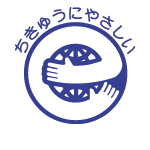 |
Number of product categories: 64 Number of authorized brands: 5,391 Number of authorized companies: 1,867 (As of 31 December) |
During the 1990s there was a burgeoning growth of product marks and labels that provided information to consumers and purchasers worldwide about the environmental standards of products. In response to the large number of these "eco-labels" in Japan and around the world, on 13 August this year the Ministry of the Environment launched full operations of a Japanese-language database on eco-labels.
This database classifies the various systems that provide environmental product information into implementing bodies and standards, and provides detailed information for each. It was started with the aim of facilitating green purchasing initiatives by allowing consumers and businesses to make proper use of environmental information about products.
The Web site includes (1) a "checklist of information sources for consideration when selecting environmental products," which explains product environmental information provision systems that are being implemented by third-parties and industry organizations, (2) a "matrix of product informa tion sources" that organizes details about the targeted products and the nature of each information source, (3) a "corporate initiatives" page, which sum marizes the independent labeling systems of various companies, (4) a question and answer section, (5) a visual index of marks registered in the database (marks by the Japanese central and prefectural governments, companies and associations, overseas governments, and international bodies), with links to more details, including procedures for companies to apply for each label, and (6) other information, including an explanation of re-use and recycling identification marks, and reference information on eco-labelling systems in other countries, etc. The site is a com prehensive source on anything relating to eco-labeling.
The main Web site is here:
www.env.go.jp/policy/hozen/green/ecolabel/index.html.
The website is entirely in Japanese, but English readers can get a visual idea of the different types of eco-labels that can be found in use in Japan, by viewing about 80 marks here: www.env.go.jp/policy/hozen/green/ecolabel/f01.html.
Official documents in English about Japan's law on promoting green purchasing are here: www.env.go.jp/en/lar/green/index.html.
For reference the Japanese typical eco-labeling system i.e.? Eco-Mark system implemented by Japan Environment Association can be reached at http://www.jeas.or.jp/ecomark/index.html and furthermore the Global Ecolabeling Network can be reached at www.gen.gr.jp.
Symposium on Environmental Endocrine Disrupters
From 26 to 28 November, the Fifth International Symposium on Environmental Endocrine Dis rupters 2002 was held in Hiro shima, organized by the Ministry of the Environment. The main aims of the symposium were to (1) share information about initiatives around the world to address the issue of endocrine disrupters, (2) discuss the directions of research on endocrine disrupters, and (3) exchange opinions about countermeasures to deal with chemical substances. About 50 researchers and governmental personnel made presentations. The program held on 26 November was open to the public, while on the next two days, the programs were designed for specialists. This year, particular attention was given to impacts on children, with a special lecture by Professor Osamu Tsutsumi M.D. from the University of Tokyo, Department of Obstetrics and Gynecology.
The English website for the symposium is http://www.env.go.jp/chemi/end/sympo2002.html.
Fluorocarbons Recovery and Destruction Law Now in Effect
Japan has reduced its production and consumption of ozone-depleting substances, in accord ance with the Montreal Protocol on Substances that deplete the Ozone Layer, and has already completed the phase-out of the production of CFCs. Whereas those efforts have resulted in considerable success, large amounts of CFCs that were produced in the past years are still used.
Amid this background, in June 2001, Japan enacted the Law for ensuring the Implementation of Recovery and Destruction of Fluorocarbons concerning Specified Products (known as the Fluorocarbons Recovery and Destruction Law), targeting CFCs, HCFCs, HFCs that are used as refrigerants for commercial air-conditioners, refrigerators and chillers, as well as mobile air-conditioners installed on motor vehicles. This law provides standards for recovery and destruction of these substances, and sets responsibilities of relevant users, operators and manufacturers involved and lays down measures to ensure the recovery and destruction of these substances.
On 1 April this year, this law entered into force except for provisions regarding recovery of the fluorocarbons from mobile air-conditioners, and on 1 October this year, the provisions regarding mobile air-conditioners went into effect.
English Edition of "Abridged and Illustrated for Easy Understanding Quality of the Environment in Japan 2002"
A special effort was made this year to ensure that the 2002 edition of Japan's annual White Paper on the Environment would be easy to read, using many charts and figures. An English version entitled Abridged and Illustrated for Easy Understanding Quality of the Environment in Japan 2002 was also produced. The main theme this year emphasizes the movement towards construction of sustainable society.
The white paper points out that to build a sustainable society, we need two healthy cycles, a socio-economic system and a natural environment. We also need advances in eco-efficiency that outpace the rate of economic growth. The ongoing efforts of various players in this direction are introduced.
The paper shows the need to take rapid action to re-think our current socio-economic systems that are based on mass production, mass consumption and mass disposal. It points out that such action can lead to major economic advantages in the long term, and that these policies could also contribute positively to the global community. The paper stresses that now there is a good opportunity to shift toward sustainable socio-economic systems, as Japan is now tackling structural reforms of the entire society.
For more information on how to obtain copies please contact the Environmental Strategy Division in the Ministry of the Environment (e-mail: hakusho@env.go.jp).
Annual White Paper for Children
 |
| Front page of Annual White Paper for Children 2002. |
The Ministry of the Environment has summarized the 2002 edition of its annual White Paper on the Environment to make it easier to understand for children in Japan. Primary and junior high schools all over Japan have each received a copy of the booklet.
Various current environmental issues and measures are illustrated in the form of a dialogue. The main characters are Izumi-chan (first year student in a junior high school), Daichi-kun (fifth grade in a primary school), Kenjyu Sennin (a forest spirit from a thousand-year-old forest) and Momo-chan, a flying squirrel. This paper introduces the work of the Ministry and environmental problems in Japan and overseas, and includes an "Eco-Life" checklist, a question and answer section, and a list of Web sites and other sources of information useful for study.
Copies may be obtained from the Gyosei Company in Tokyo (telephone 81-3-5349-6654), for 150 yen each. (Postage is not included in the price.)
| 2003 | |
| February | |
| 3-7 | UNEP 22nd Session of the Governing Council/Global Ministerial Environment Forum (Nairobi, Kenya) |
| March | |
| 16-23 | The Third World Water Forum (Kyoto,Shiga and Osaka, Japan) |
| 23-25 | International Conference on Environmentally Sustainable Transport in the Asian Region (Nagoya, Japan) |
| April | |
| 25-27 | G8 Environment Ministers Meeting (France) |
| 28-9 May | United Nations Commission on Sustainable Development (CSD) (New York, USA) |
| May | |
| 26-Jun. 6 | Third Session of United Nations Forum on Forests (Geneva, Switzerland) |
Ministry of the Environment Government of Japan
moe@env.go.jp